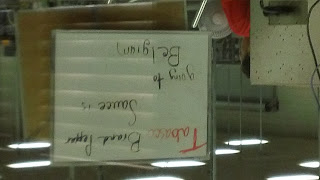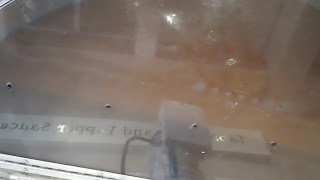Wednesday, October 24, 2012
Tabasco and Avery Island
Avery Island is a salt dome best known as the source of Tabasco Sauce. Located in Iberia Parish, Louisiana, United States, it is about three miles (5 km) inland from Vermilion Bay, which in turn opens onto the Gulf of Mexico.
Tabasco sauce was first produced in 1868 by Edmund McIlhenny, a Maryland-born former banker who had moved to Louisiana around 1840. Initially McIlhenny used discarded cologne bottles to distribute his sauce to family and friends, and in 1868 when he started to sell to the public he ordered thousands of new "cologne bottles" from a New Orleans glassworks. It was in these that the sauce was first commercially distributed. On his death in 1890, McIlhenny was succeeded by his eldest son, John Avery McIlhenny, who expanded and modernized the business, but resigned after a few years to join Theodore Roosevelt's Rough Riders volunteer cavalry regiment. On John's departure, brother Edward Avery McIlhenny, a self-taught naturalist fresh from an Arctic adventure, assumed control of the company and focused on expansion and modernization, running it from 1898 to his death in 1949. His successor the war veteran Walter S. McIlhenny served in the U.S. Marines at Guadalcanal before taking over the company until his death in 1985. Paul C. P. McIlhenny is the sixth in a line of McIlhenny men to run the business.
Until recently, all Tabasco peppers were grown on Avery Island. While a small portion of the crop is still grown there, the bulk is now grown in various locations in Central and South America. More predictable weather and readily available farmland allow a larger year-round supply. This also helps to ensure the availability of peppers in case of severe weather, or other problems, at a particular location. (All seeds are still grown on Avery Island.)
Following company tradition, the peppers are handpicked. To determine ripeness, peppers are compared to a little red stick (le petit bâton rouge) that each worker carries. Peppers that do not match the color of the stick are not harvested. Harvested peppers are ground into a mash on the same day they are harvested and then placed, along with salt, in white oak barrels (aging barrels previously used for Jack Daniel's Tennessee whiskey). The barrels are then sent to warehouses on Avery Island for a three-year aging process. After aging, the mash is strained to remove skins and seeds. The resulting liquid is mixed with vinegar, stirred occasionally for a month, and then bottled as finished sauce. Much of the salt used in Tabasco production comes from an Avery Island salt mine, one of the largest in the U.S.
Avery Island was hit hard by tropical storms in 2005, especially Hurricane Rita. The factory barely escaped major damage. As a result of a long history of dodging tropical storms, the family constructed a 17-foot (5.2 m)-high levee and invested in back-up generators.
McIlhenny Company produces Tabasco brand products that contain pepper seasoning, including popcorn, nuts, olives, mayonnaise, mustard, steak sauce, Worcestershire sauce, soy sauce, teriyaki sauce, marinating sauce, barbecue sauce, chili sauce, pepper jelly, and Bloody Mary mix. McIlhenny Company also permits other brands to use and advertise Tabasco sauce as an ingredient in their products (a common marketing practice called "co-branding"), including Spam, Slim Jim beef sticks, Heinz ketchup, A1 steak sauce, Plochman's mustard, Cheez-It crackers, Lawry's salt, Zapp's potato chips and Vlasic pickles.
The original red Tabasco sauce has a shelf life of five years when stored in a cool and dry place; other Tabasco flavors have shorter shelf lives
During the Vietnam War, BGen. McIlhenny issued The Charlie Ration Cookbook. (Charlie ration was slang for the field meal given to troops.) This cookbook came wrapped around a two-ounce bottle of Tabasco sauce in a camouflaged, water-resistant container. It included instructions on how to mix C-rations to make such meals as "Combat Canapés" or "Breast of Chicken under Bullets."
During the 1980s, the U.S. military began to include miniature bottles of Tabasco sauce in its MREs. Eventually, miniature bottles of Tabasco sauce were included in two-thirds of all MRE menus. (These same miniature bottles are also included in British MOD rations.) During the same period, McIlhenny Company issued a new military-oriented cookbook using characters from the comic strip Beetle Bailey, titled The Unofficial MRE Cookbook, which it offered free of charge to U.S. troop
Subscribe to:
Post Comments (Atom)


























No comments:
Post a Comment